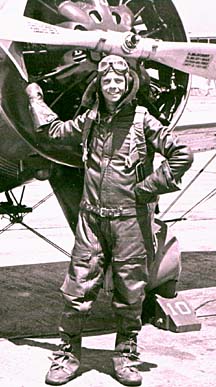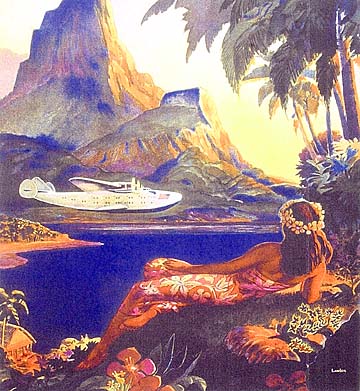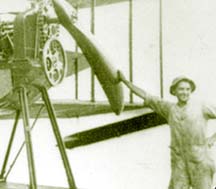
GRAPHIC BY BURL BURLINGAME
Soldiers cheer as Maitland and Hegenberger’s Fokker C-2 lands at Wheeler Field.100 milestones of
Hawaii aviation history
1. Pre-Contact: According to legend, the demi-god Maui fashions a craft of twigs and o'o feathers and flies over Hawaii.
2. March 1889: Emil Melville fails to fly a hot-air balloon over windy Kapiolani Park.
3. November 1889: Balloonist Joseph Van Tassell makes the first recorded flight in the islands from the slopes of Punchbowl, but fell into the ocean and disappeared.
4. 1891: An article by E. Ellsworth Carey appears in Hawaii newspapers predicting U.S. Navy ships sunk by bombs dropped from flying machines.
Civilian barnstormer Ernie Smith.
5. February 1897: Professor James Price flies a balloon to 3,000 feet above "Remond Grove, Oahu," before parachuting to earth.
6. October 1910: Two teenage brothers, Malcom and Elbert Tuttle, build and fly a glider several times off the slopes of Diamond Head.
7. December 1910: Aviator J.C. "Bud" Mars flies the first real aircraft in the islands, circling Moanalua Gardens. The Curtiss pusher is dubbed the "Honolulu Skylark."
8. June 1911: Clarence Walker takes off from a park in Hilo and crashes into a tree, one of the shortest flights in Hawaii history.
9. June 1911: French adventurer Didier Masson flies a Bleriot from Schofield Barracks to Kapolanai Park in the first monoplane flight in Hawaii, covering 19 miles in 22 minutes.
10. December 1911: Barton Dryer flies Hawaii's first homebuilt airplane -- designed and built by Gus Schaefer -- but crashes.
11: July 1913: An Army flying detachment commanded by Harold Geiger set up shop at at Fort Kamehameha but later abandons flying in the islands because of too-strong tradewinds.
12. October 1913: Chinese pilot Tom Gunn takes the first "paying passengers" aloft over Honolulu and Hilo.
13. 1914: Okinawan mechanic Shigeru Serikaku makes the first successful flight of a homebuilt aircraft in the islands.
14. October 1916: The first pilot's license in the islands is issued to Chinese aviator Young Sen-Yat, who vows to buy an airplane "and take it to the land of the hula-hula."
15. 1917: The US enters the Great War and the Army's 6th Aero Squadron encamps on Ford Island.
16. 1917: Hawaiian songwriter R. Alexander Anderson enters the Royal Flying Corps, inspiring the film "Hell's Angels."
17. 1917: Lanikai resident Carl Dolan flies with the Lafayette Escadrille volunteer air corps in France.
18. 1918: Lt. Frank Bellows dis in the final days of the Great War, and Bellows Air Station is later named after him.
Gentleman pilot Walter Dillingham and a P-26 Peashooter.
19. 1918: Maj. Harold Clark flies the first inter-island flight from Oahu to Molokai and returns. Another flight to the Big Island results in a crash.
20. 1918: Lt. Frank Luke wins the Medal of Honor on the Western Front, and Luke Field on Ford Island is named for him in 1919.
21. July 1919: First official airmail goes from Honolulu to Hilo in Army planes.
22. 1919: Naval aviation comes to Hawaii, operating in Pearl Harbor.
23. February 1920: Charles Fern carries the first paying passenger on an interisland flight from Kapiolani Park to Makawao, Maui, with unplanned stops on Molokai and Kahului.
24. 1921: The 11th Photo Section begins an aerial mapping survey of the islands, revealing areas not even visited by Hawaiians.
25. 1922: Wheeler Field named for Maj. Sheldon Wheeler, killed in an accident over Ford Island.
26. October 1923: Charles Stoffer in a surplus Curtiss JN-4H "Charley's Crate" delivers newspapers to Molokai and Maui.
27. August 1925: Cmdr. John Rodgers attempts the first flight from California to Hawaii, but run out of fuel en route.
28. 1925: The Honolulu Chamber of Commerce raises $20,000 and the City of Honolulu appropriates $45,000 for airport construction. The new airport is named John Rodgers Field.
29. 1925: The city of Hilo identifies 100 acres of land and sets aside $10,000 for construction of an airport.
30. 1926: Lewis Island Tours begins aerial tours.
31. June 1927: Army Lts. Lester Maitland and Albert Hegenberger succeed where the Navy failed, a nonstop hop to Oahu.
32. July 1927: Aviators Ernest Smith and Emory Bronte are the first civilians to fly in from the mainland, crashing on Molokai.
33. August 1927: The "Dole Derby" race from Oakland to Hawaii becomes an aerial disaster. Two aircraft of 14 entered finish; of the others, seven aircraft crash or disappear with 10 lives lost.
34. 1927: $15,000 allocated for airport at Maui.
35. 1927: Territorial land set aside for an airport on Molokai.
36. 1928: $15,000 set aside for an airport on Kauai at Port Allen.
37. June 1928: Sir Charles Kingsford-Smith flies a trimotor called "Southern Cross" across the Pacific, stopping at Wheeler Field.
38. November 1929: The first commercial inter-island air service is established by Inter-Island Airways (now known as Hawaiian Airlines) with scheduled service between the islands.
39. 1929: Twice-weekly flights initiated to Port Allen, Kauai.
40. 1930: Olen V. Andrew begins barnstorming to raise money for the first professional flight school in the islands.
41. 1930: Inter-island Airways begins service to Lanai.
42. 1931: Army aircraft begin the reforesting of Hawaii mountains, air-dropping seedlings.
43. December 1931: Army gliding enthusiast Lt. William A. Cocke goes aloft in "Nighthawk" over the Pali, setting a record.
44. February 1932: During war games between the Army and Navy, an aerial attack on Pearl Harbor is a surprising success.
45. April 1933: A mass flight of Navy seaplanes stays in formation to French Frigate Shoals and back.
46. 1933: Five additional Army airfields are opened to handle increased aerial activity -- Bellows, Putnam, Buros, Suiter and Morse Fields.
47. January 1934: Another formation of Navy planes flies from San Francisco to Pearl Harbor.
48. November 1934: Sir Kingsford-Smith makes the first eastbound flight from Hawaii to Oakland in "Lady Southern Cross."
49. December 1934: Another trans-Pacific flight is attempted by Charles P.T. Ulm, but his aircraft vanishes near Hawaii.
50. January 1935: Amelia Earhart is the first aviator -- of either sex -- to fly solo between Hawaii and the mainland.
51. April 1935: The first commercial flight from the mainland to Hawaii is flown by Pan American Airways in just over 17 hours.
Vintage Pan American travel poster.
52. November 1935: The first scheduled air mail and passenger service begins across the Pacific in Pan Am's giant "clipper" aircraft.
53. 1936: In a desperation move, Army airplanes drop bombs on an erupting lava flow and redirect it away from Hilo.
54. March 1937: Amelia Earhart attempts a around-the-world flight, but groundloops on take-off from Luke Field. She disappears during a later attempt in the South Pacific.
55. 1939: The Army begins to move aircraft and equipment from Luke Field to Hickam Field, named after Lt.Col. Horace Meek Hickam, killed in an aircraft accident in 1935. The Navy completely takes over Ford Island.
56. 1939: The Navy begins construction on a second naval air field at Kaneohe Bay.
57. April 1940: Army bombers again redirect lava by bombing on the Big Island..
58. 1940: A record 1,153 people fly to Hawaii from the mainland. The 16-hour flight costs $278.
59. September 1940: Qantas Empire Airways begins flying though Hawaii, secretly delivering flying boats to Australia.
60. 1941: Inter-Island Airways absorbs bankrupt Hawaiian Airways, changes name to Hawaiian Airlines and switches to the modern DC-3 airliner.
61. December 1941: The most powerful striking force in the world, the six aircraft carriers of the Imperial Japanese Navy's "Kido Butai" task force, cripples the U.S. Fleet at Pearl Harbor.
62: January 1942: The Women's Air Raid Defense Service (WARDS) is created at Fort Shafter, and the Hawaii women who serve are the first American women stationed in a combat zone.
63. 1942: The Navy takes control of John Rodgers Airport, calling it Honolulu Naval Air Station.
64. March 1942: A second attack on Pearl Harbor goes awry when Japanese seaplane bombers lose their bearings at night and jettison bombs behind Punahou School.
65. June 1942: The Imperial Navy is mauled near Midway and invasion plans for Hawaii put on hold. The Battle of Midway is considered, with the Battle of Britain, one of the most decisive aerial conflicts in history.
66. 1943: The most dangerous day in Hawaii aviation history occurs when nearly 30 Army and Navy aircraft collide during rainy maneuvers over Kauai. During the war, more than 5,000 aircraft crash in the islands during training accidents.
Army pioneer Harold Geiger and the Curtiss Model G Tractor Scout.
67. 1944: Wah Kau Kong becomes Hawaii's first Chinese-American fighter pilot, flying 14 missions over Europe and scoring two kills before being killed in combat in his P-51 Mustang.
68. 1945: Coast Guard aviation arrives when 18 enlisted men, five officers, two PBY-5 Catalinas and one JRF Goose are assigned to Kaneohe Naval Air Station.
69. 1946: Hawaiian Airlines resumes service after a hiatus.
70. 1946: Trans-Pacific (later, Aloha Airlines) begins passenger service in the islands, beginning a long-standing rivalry with Hawaiian Air Lines.
71. August 1946: Two radio-controlled B-17 bombers fly 2,174 miles from Hawaii to California with no one at the controls.
72. October 1946: The B-29 "Pacusan Dreamboat" flies 9,444 miles nonstop between Hawaii and Cairo, passing over London.
73. February 1947: Lts. Robert Thacker and John Ard fly a P-82 fighter nonstop between Hawaii and New York, more than 5,000 miles.
74. 1947: United Airlines begins a still-ongoing relationship with Hawaii.
75. 1947: John Rodgers Airport is renamed Honolulu International Airport.
76. 1947: Territory of Hawaii Air National Guard founded with war-surplus P-47Ns, A-26s and a T-6 trainer.
77. 1948: Trans-Pacific introduces the first in-flight entertainment when they feature singing, hula-dancing and ukulele-playing flight stewardesses.
78. 1949: Lihue Airport opens.
79. 1951: Honolulu International Airport and Hickam Air Force Base are finally linked by a 200-foot wide runway, plus joint air-traffic control.
80. 1951: Air travel to Hawaii increases to 153,598, a 13,000 percent increase over the previous decade.
81. 1954: Japan Air Lines begins service to Hawaii and on to San Francisco, becoming the first Asian carrier to serve the islands.
82. 1956: Running low on fuel, a Pan Am Stratocruiser ditches halfway between Honolulu and San Francisco next to a Coast Guard ship. The crew and passengers are all saved.
83. 1959: Qantas Airlines begins the first jet service across the Pacific with Boeing 707 aircraft stopping off in Honolulu.
84. July 1961: Geza Vass and Guy Davis set a world endurance gliding record or 71 hours in a Civil Air Patrol sailplane.
85. 1961: Jeanne Davis of Kailua becomes the first woman to solo in a glider in Hawaii.
86. 1962: A four-engine turboprop crash at Honolulu International Airport kills 27, the worst civilian air-carrier accident in the history of the islands.
87. April 1964: Geraldine Mock and Joan Merriam pass through Hawaii in opposite directions on legs of around-the-world flights.
88. July 1969: The Columbia reentry module with Neil Armstrong, Buzz Aldrin and Michael Collins lands near Hawaii.
89. December 1969: Apollo 13 with James Lovell, Fred Haise and John Swigert lands in Hawaiian waters.
90. 1969: The attack on Pearl Harbor is recreated with dozens of aircraft for the movie "Tora Tora Tora."
91. 1970: Jumbo jet service comes to Hawaii.
92. 1973: Construction begins on the reef runway.
93. January 1978: Test pilot Ellison Onizuka is accepted as an astronaut candidate, becoming Hawaii's first space man.
94. 1979: Airlines are de-regulated.
95. April 1988: An Aloha Airlines Boeing 737 loses 18 feet of its fuselage at 24,000 feet, managing to land on Maui with the loss of one occupant.
96. 1989: Honolulu International Airport's Reef Runway is chosen as one of several emergency landing sites for the NASA Space Shuttle.
97. December 1991: After two decades of false starts, the Pacific Aerospace Museum opens in the heart of Honolulu International Airport. It is closed in 2001 and demolished in 2003.
98. July 1993: The Inter-Island Terminal at Honolulu International Airport opens its doors for business after more than 10 years of planning, debate and construction.
99: August 2001: NASA's solar-powered plane Helios soars to 96,500 feet over Kauai, setting an altitude record.
100: September 2001: All air traffic in and out of the islands is shut down in the wake of the World Trade Center attacks, reminding residents of their dependency on aviation.
Honolulu Community College history and aviation-safety instructor Robert Dixon also contributed to this list.




